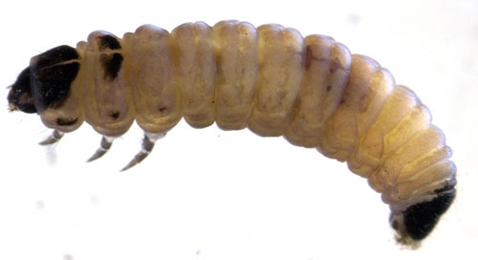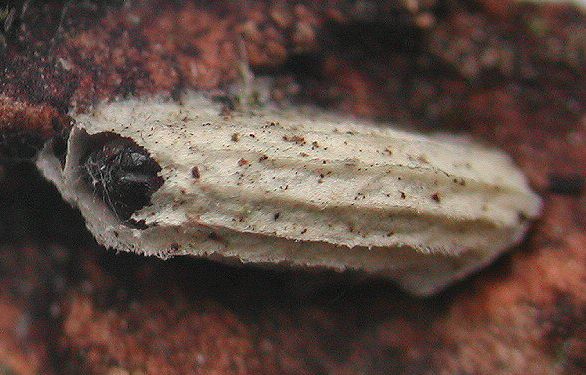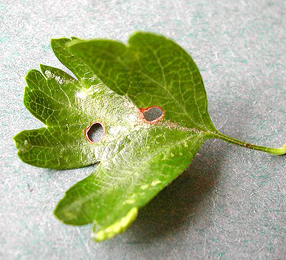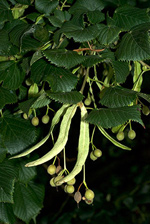|
||||||
|
TILIA. Limes. [Tiliaceae] |
|
|
Six species, subspecies and hybrids of Tilia are recorded in Britain. These include the native Large-leaved Lime (T. platyphyllos) and Small-leaved Lime (T. cordata). The BSBI provide a downloadable plant crib for Tilia. Twelve British miners are recorded on Tilia. A key to the European miners recorded on Tilia is provided in Bladmineerders van Europa. |
|
|
Key for the identification of the known mines of British |
1a > Leaf-miner and case-bearer: The larva lives outside the mine, protected by a case, and feeds on the underlying plant tissues via a hole cut in the epidermis. From that point it eats away as much leaf tissue as it can reach without fully entering the mine. Mine does not contain frass (Coleophora species) |
| 1b > Leaf-miner, but not a case-bearer: The larva lives mainly inside the mine. Mine usually contains frass. In later instars the larva may live sandwiched between two more or less circular sections cut from the leaf. |
2a > Leaf-miner and case-bearer: The early case is tiny and the larva makes a series of tiny holes on the leaf. After overwintering it makes a shiny pistol shaped case in spring and window feeds. The young larva, before hibernation, makes tiny mines, sometimes tens in one leaf. After hibernation window feeding is done. In this latter stage the larva lives in a shining black pistol case of about 7 mm, that, with a mouth angle of 70°-80°, stands almost perpendicular on the leaf. |
|
Coleophora anatipenella (Hübner, 1796) [Lepidoptera: Bucculatricidae]. |
2b > Leaf-miner and case-bearer: Tubular leaf case. The case is almost barrel-shaped, with a large leaf fragment that, while withering, folds itself untidily arround the tube. A biennial life cycle in the UK (may be annual in continental Europe). The second and third cases are formed by cutting out a large leaf portion and then wrapping it around - leaving an edge protruding, which then withers. |
|
Coleophora siccifolia Stainton, 1856 [Lepidoptera: Coleophoridae]. |
2c > Leaf-miner and case-bearer: The larva feeds on a wide range of trees, shrubs and herbs, favouring Rosaceae, but not exclusively. The fully developed cased larva may be found active in October and again, after winter diapause, in April. Cases, about 6 mm, of diapausing larvae may be found through winter, fixed to a tree or fence post. The dorsal surface of the case is usually covered in leaf fragments, but they can sometimes be worn off almost smooth. The ventral surface is swollen at the middle and has a keel, which usually bends upwards at the posterior. The cases of C. ahenella (on Rhamnus, Frangula, Viburnum and Cornus) and C. potentillae (case less swollen, keel not bent up, resting position less prone) are very similar. Brownish lobe case that lies almost flat on the leaf, either on the upper or on the lower side. Case widest about the middle. Ventrally there is a distinct keel. Mouth angle 0°. Full depth mines rather large. The flaps of cuticular tissue that serve to enlarge the case are cut out of the upper epidermis. (contrary to C. ahenella and C. potentillae, that use tissue from the lower epidermis). The removal of these tissue flaps creates holes that are much larger than those that serve as the entrance to the mine. |
 Coleophora violacea larva, lateral Image: © Willem Ellis (Bladmineerders van Europa) |
|
Coleophora violacea (Ström, 1783) [Lepidoptera: Coleophoridae]. |
3a > Leaf-miner: The larvae mine the leaves at first, then create small feeding windows. Small, full depth, hook-like corridor, usually in a vein axil, with a proportionally large larval chamber. The remainder of the mine almost entirely stuffed with frass. At the start if the mine an iridescent egg shell. The larvae soon leave their mine and start living free on the leaf. The pupa and white ribbed cocoon are illustrated in British leafminers. |
 Bucculatrix thoracella cocoon Image: Rob Edmunds (British leafminers) |
|
Bucculatrix thoracella (Thunberg, 1794) [Lepidoptera: Bucculatricidae]. |
3b > Leaf-miner: The larvae mine leaves at first, forming a blotch mine, later descending to the ground in a portable case and feeding on dead leaves. Oviposition is by way of an ovipositor, therefore no egg shell visible. The larva makes a small, roundish, blotch; often several in a leaf. Already after its first moult it makes an excision out of the mine, in size almost equal to the blotch (3-4 mm). Thus sandwiched it drops to the ground and continues feeding on dead leaf material. |
 Mines of Incurvaria masculella Image: © Rob Edmunds (British leafminers) |
|
Incurvaria masculella (Denis & Schiffermüller, 1775) [Lepidoptera: Incurvariidae]. |
| 3c > Leaf-miner: The larva starts making a corridor of a few mm, followed, and mostly overrun, by a circular blotch of 4-5 mm diameter. Generally several larvae feed in a single leaf, creating a distinctive pattern of feeding windows. The larvae then cut out circular cases and drop to the leaf-litter to continue feeding, leaving behind a leaf containing many circular or oval cut-outs. |
|
Incurvaria pectinea Haworth 1828 [Lepidoptera: Incurvariidae]. |
3d > Leaf-miner: A flat blotch at the leaf margin. The leaf is not rolled inwards over the mine. Rarely more than one mine per leaf. Mines mainly in the canopy. The larvae of sawflies have at least six thoracic legs (although they may be reduced or absent), a head capsule and chewing mouthparts with opposable mandibles but no abdominal legs. |
|
Parna apicalis (Brischke, 1888) [Hymenoptera: Tenthredinidae]. |
3e > Leaf-miner: A somewhat inflated full depth blotch, that begins at the leaf margin. The oviposition causes the leaf to roll inwords, covering (and hiding) the mines. Often several mines in a leaf. Mainly in suckers. The larvae of sawflies have at least six thoracic legs (although they may be reduced or absent), a head capsule and chewing mouthparts with opposable mandibles but no abdominal legs. |
|
Parna tenella (Klug, 1816) [Hymenoptera: Tenthredinidae]. |
3f > Leaf-miner: The mine is oval on Q. ilex (note - there may be several mines in the leaf), and similar to P. quercifoliella on deciduous oaks. It is between adjacent veins on beech and hornbeam. Small, oval, lower-surface tentiform mine, 9-14 mm long, mostly between two lateral veins. The lower epidermis with a single sharp fold (sometimes forked near its end). Pupa in very flimsy cocoon, that contains a bit of frass laterally and at the rear end. |
|
Phyllonorycter messaniella (Zeller, 1846) [Lepidoptera: Gracillariidae]. |
3g > Leaf-miner: The larvae feed on the leaves of lime and birch, mining the leaves when young. Oviposition at the leaf upperside. Mine a short, irregular, full depth corridor, always at the leaf margin, generally in the tip of the leaf. Frassly broadly scattered. The older larva lives free on the leaf. |
|
Roeslerstammia erxlebella (Fabricius, 1787) [Lepidoptera: Roeslerstammiidae]. |
3h > Leaf-miner: A contorted gallery, early part in underside of leaf. Egg at the underside of the leaf. The mine is a gradually widening corridor. Its first part generally is lower-surface, hardly visible from above; further on the mine is full depth. Frass deposition very variable, mostly in a narrow central line throughout, but sometiimes widely dispersed or even coiled. |
|
Stigmella tiliae (Frey, 1856) [Lepidoptera: Nepticulidae]. |
| 3i > Leaf-miner: Full depth blotch, invariably beginning at the leaf tip or the tip of a leaf lobe or tooth. Oviposition site covered by a black, shining drop of hardened secretion. Frass generally in long threads, but sometimes in elongated granules. Pupation in the mine, not in a cocoon. |
|
Trachys minutus (Linnaeus, 1758) [Coleoptera: Buprestidae]. |
| Last updated 04-Feb-2018 Brian Pitkin | ||

